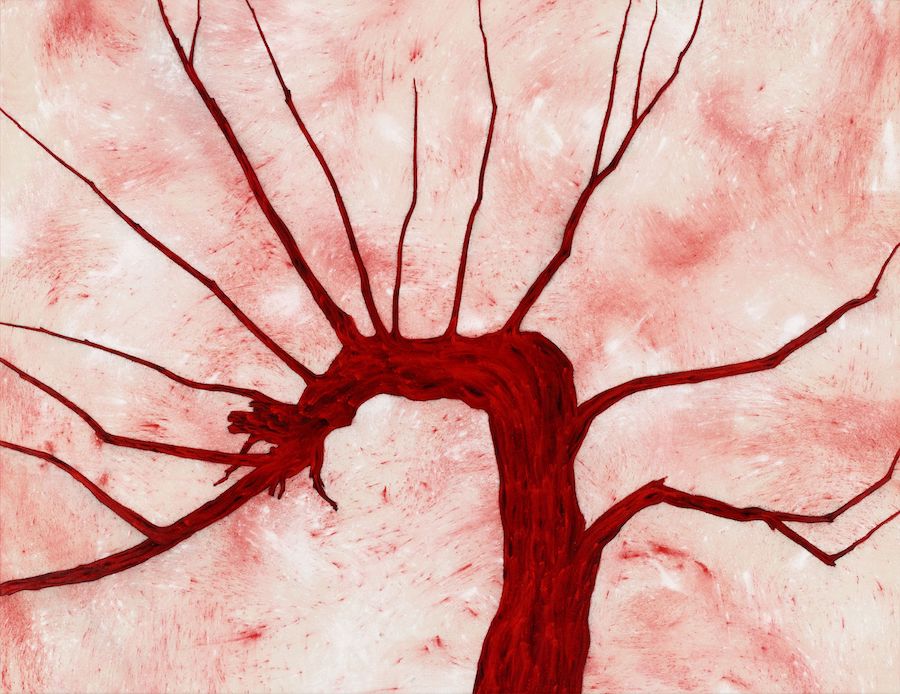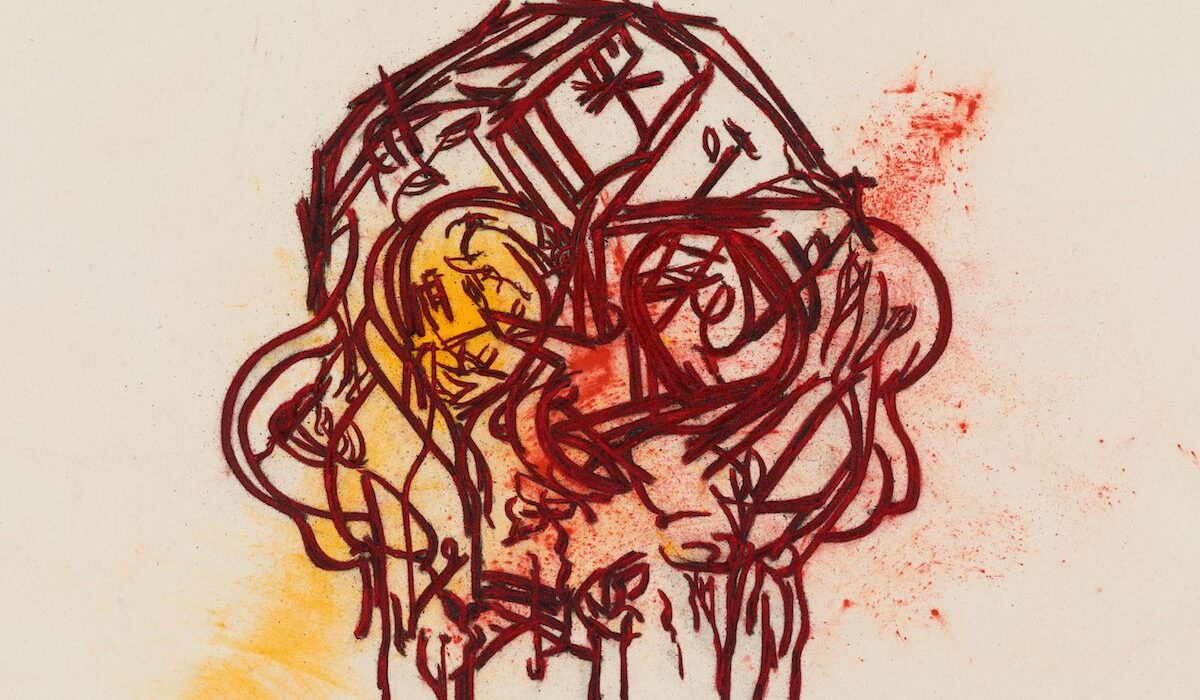An epistrophe is a word or phrase repeated at the end of a sentence to emphasise or heighten emotion. Derived from the ancient Greek, it implies a turning back, a revisiting. Plato used it as a tool for philosophical education, and later, it was taken up by the early Christians to signify conversion. Tony Bevan has named his new body of work Epistrophes and Heads. Repetition, similar to the phrasing within a tune or a melody, is a feature of his singular mark-making. Work is begun on the floor so that with the pressure of his body, the charcoal he uses shatters to leave a trace like a record of the piece’s making. Each line is dictated by the reach of his arm, even the length of his breath. This elemental process connects him back to the earliest drawings made by man on cave walls in an attempt to tame and make sense of their world.
Over the years, Tony Bevan has explored a specific range of subjects, including heads and architectural spaces, using them as vehicles to analyse reality. Citing Gaston Bachelard, he describes the picture space as a place of discovery, a ‘crucible of the imagination.’ Alone in his studio, he comes face to face with an empty canvas or blank sheet of paper before setting out into the unknown, driven only by a desire to express what is often inchoate and unnameable. His bold lines suggest a voyage of discovery, but with each departure and return, things are perceived slightly differently, experienced from an alternative perspective. There is never a single reading, a consistent viewpoint. He offers questions in a world of perpetual shift and flux.
Like Jason setting out on the Argo for the golden fleece, Tony Bevan’s images evoke a spirit of exploration and quest. The point of arrival is uncertain. It is the journey that is significant. As the critic Roland Barthes noted of the Argo, during its long voyage, the ship was slowly replaced plank by plank, thereby posing the question as to whether the vessel heading home was the same as the one that had initially set sail.
This revisiting and circularity evokes T. Eliot’s lines:
And the end of all our exploring
Will be to arrive where we started
And know the place for the first time.
Essentially self-portraits, Bevan’s heads expose the self that resides hidden from public view. In his earlier works, he was more recognisable as the subject, but slowly, they have undergone a metamorphosis to expose – like the architectural beams of his roofs and buildings – the supporting structures and psychological armature that make up his inner self. The swirling arabesques set out and return in a series of variations so, like the writing process, they grapple their way towards a possible meaning. There is an affinity with the experimental psychedelic mark-making of the French poet and painter Henri Michaux, with his emphasis on ‘the strangeness of natural things and the naturalness of strange things.’ Bevan’s head highlights the anxieties that we most often suppress. Colour is never an afterthought but integral to the image and its essence. Sculptural and almost three-dimensional, they seem to float anxiously in space even more than Giacometti’s. There is nothing to ground them. Permeated with an ever-present sense of alienation, there is a tension between inner and outer. Mood or facial expression is never divulged. What we see is the scaffolding of the mind. Like x-rays, these works seem to peer under the skin to reveal the psychic exhaustion beneath.

In the accompanying tree paintings, branches reach out from a bare trunk to the four edges of a pale canvas. We read the image as a tree because of the suggestion of a horizon line. Painted in deep cadmium red over crushed charcoal, the twisted limbs might be understood as the inner workings of the body: a network of bronchioles or arteries, even neural pathways. Bevan’s trees are born from an actual tree that he passes daily to his studio, but the paintings are not ‘studies.’ They don’t tell us about the life of a particular tree and are not descriptive. The tree simply acts as scaffolding on which to hang his emotions; It is a vehicle to explore his thought processes through the medium of paint, to map his unconscious imagination as a cartographer might chart new land. The meaning remains open and depends on what the viewer brings to the process of looking. For some, the waving branches might be understood as Chi, the current of energy believed in traditional Chinese Medicine to be the life force and measure of one’s vitality. Or they might evoke the yogic ‘dragon breath’ where, with an inhale and a strong snorting exhale, the belly is gently pushed back towards the spine in an act of mindfulness. Unlike in the West, where it signals danger, red in many Asian cultures is believed to bring luck and ward off evil. In China, it is worn by brides to bring happiness and joy.
Bevan’s trees stand quite alone. The branches have bent to accommodate the vagaries of wind and weather. There is no decoration. Nothing extraneous. For those of us brought up with European modernism, they might evoke Beckett’s Waiting for Godot, where Beckett’s tramps Estragon and Vladimir wait on a barren road beneath just such a tree. At one point, they contemplate hanging themselves from it to escape their pitiful existence. Thus, the tree becomes a signifier of death. When, later, they notice a few small leaves on the previously bare branch, this offers a ray of possibility in their bleak existential lives. Tony Bevan’s trees carry many of the same resonances as Beckett’s. There’s the suggestion of Calvary, Christ on the Cross, death, and possible redemption.
Similarly, these painted red gashes evoke Goya’s mutilated body impaled on a broken branch in the Disasters of War. Violence never feels to be far from the surface. In one painting, the trunk has become so distorted that it looks like an arched body bent backwards in great pain or the throes of a scream, evoking the righthand figure in Bacon’s Three Studies for Figures at the Base of the Crucifixion.
In a conversation between Georges Duthuit and Samuel Becket, [1] Beckett talked of an art ‘weary of puny exploits…of going a little further along [the same] dreary road’. When asked what the creative alternative was, he responded with his now infamous phrase: ‘There is nothing to express, nothing with which to express…together with the obligation to express.’ This nihilistic remark echoed the cultural desolation felt by many post-war thinkers and artists. Subsequently, the world has changed. In our post-industrial, technological world, art and culture have taken on different values. There has been a tendency to flatten so that everything is presented as of equal or no value. The history of Western painting is the history of painting’s attempts to escape from inevitable exhaustion and failure. There is an understanding that failure is built into the artist’s destiny, that to shrink from it is a form of dereliction and that all that can be done is to start and see where the journey leads.
Yet, for many younger artists, such concerns are of little interest. They belong to a different era. Art, for all its apparent shock and awe, has, in many instances, returned to the bourgeois, pandering first and foremost to the market rather than addressing our existential anxiety and dilemmas. Tony Bevan’s intelligent works have never accepted this limitation. For him, painting is a proposition. One that asks how far we can explore the act of painting in a fast-moving world of cyborgs and AI. It can still be seen as a valid humanistic enterprise, able to fill our deepest spiritual needs and feed our souls.
TONY BEVAN EPISTROPHIES AND HEADS 23 November 2023 – 13 January 2024 Ben Brown Fine Arts 12 Brook’s Mews, London W1K 4DG
1. From the English version by Samuel Beckett and Georges Duthuit, Proust: Three Dialogues, London, 1965.
Sue Hubbard is an award-winning poet, novelist and art critic. She has published three novels, a book of short stories and five collections of poems, Her latest, Radium Dreams, is on show at The Women’s Art Collection, Murray Edwards College, with artwork by Eileen Cooper. Her poems on the life of Gwen John, God’s Little Artist, are due later this year from Seren. Flatlands, her fourth novel, is to be published by
Visit: www.suehubbard.com

